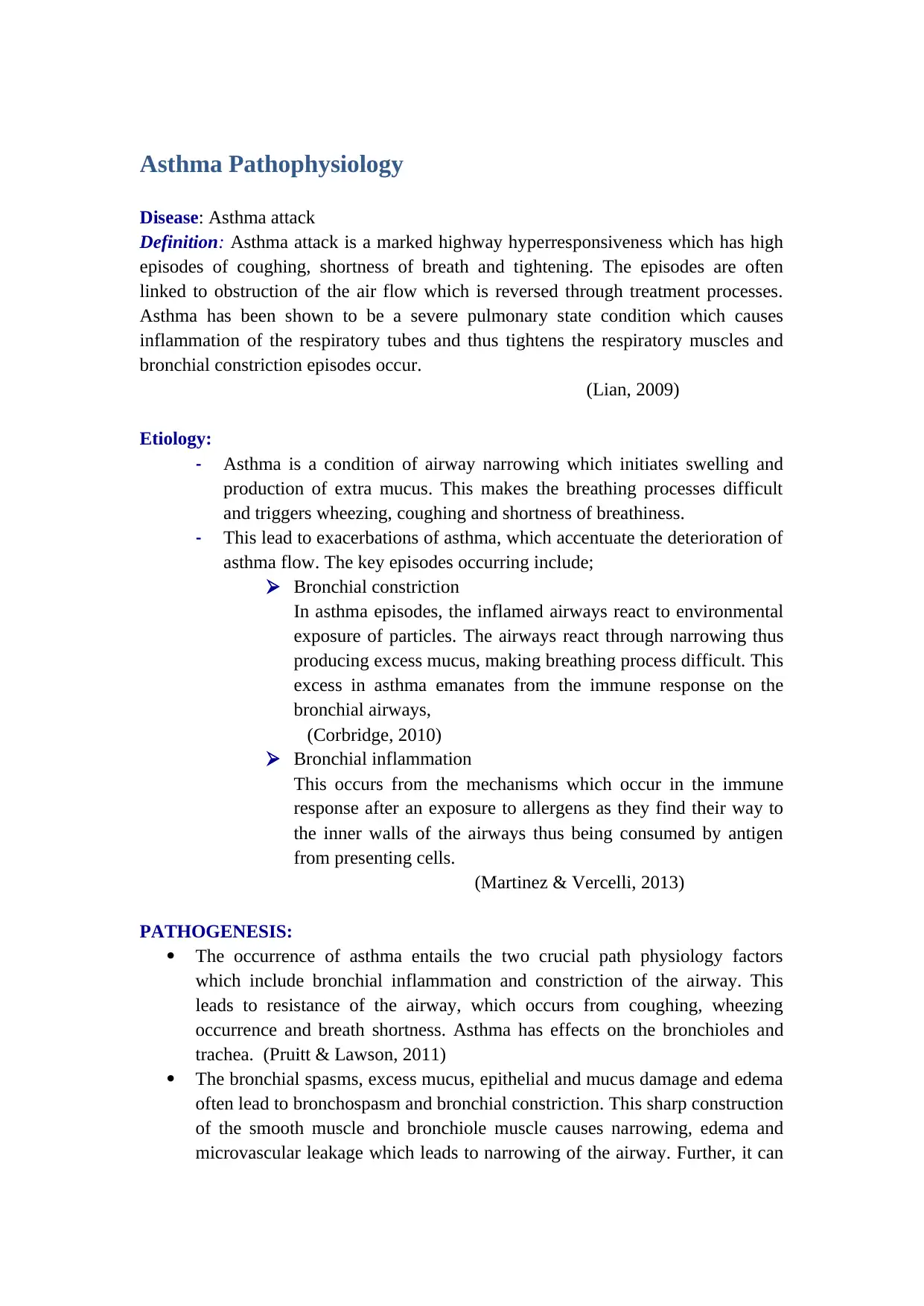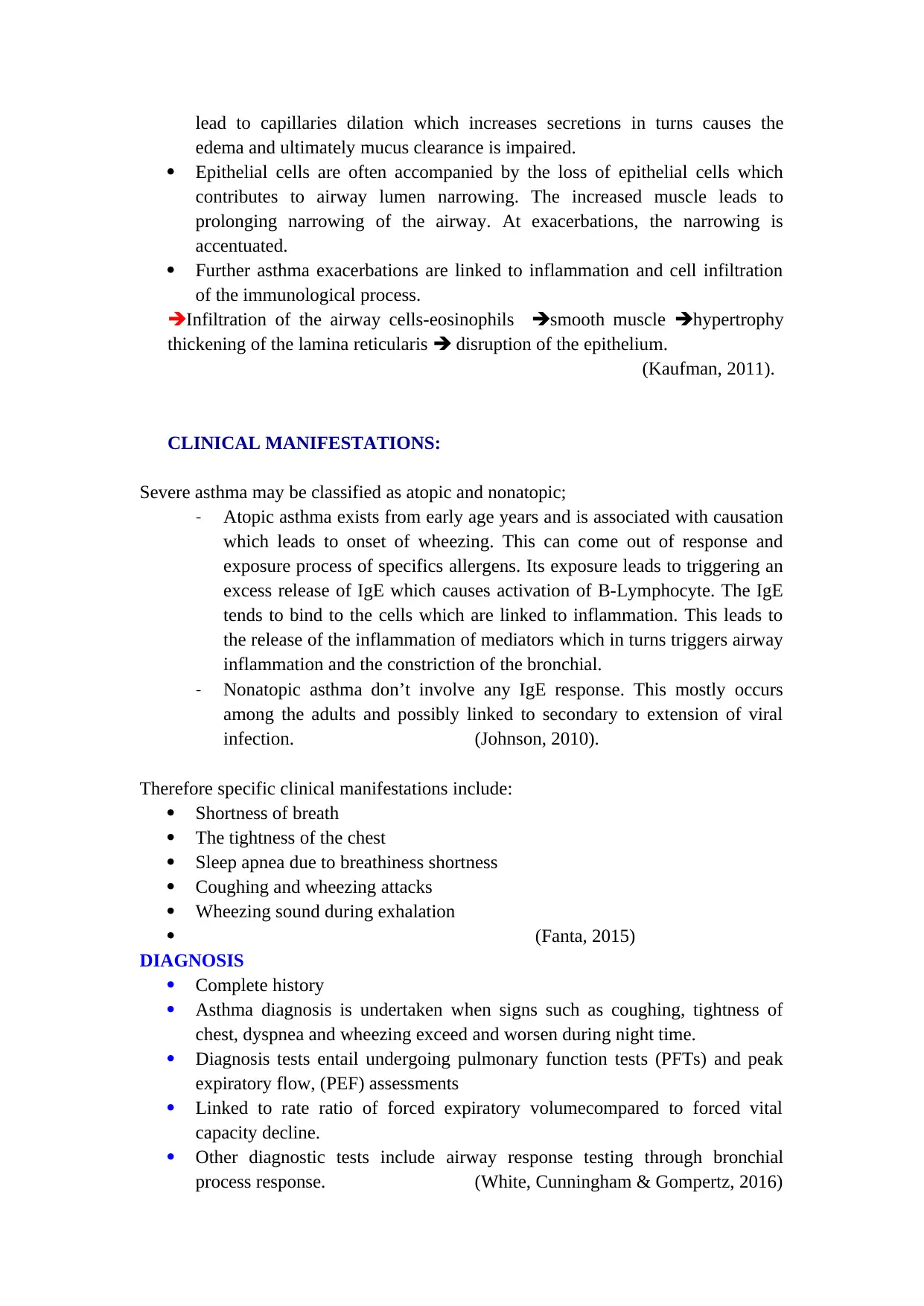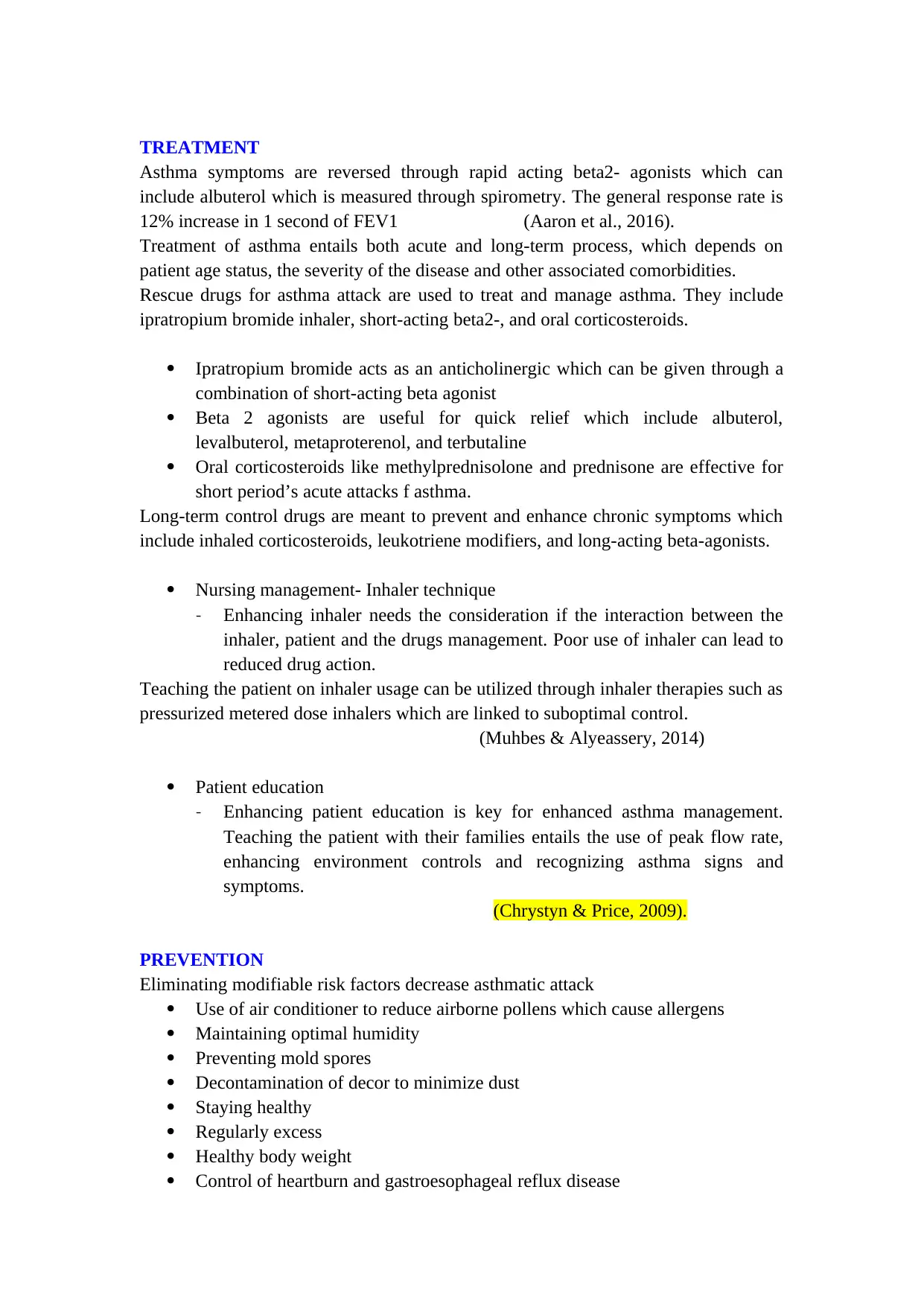Asthma Pathophysiology: A Comprehensive Overview of the Disease
VerifiedAdded on 2023/06/05
|6
|1451
|136
Report
AI Summary
This report provides a comprehensive overview of asthma pathophysiology, covering the definition, etiology, and pathogenesis of the disease. It details the mechanisms of bronchial constriction and inflammation, along with the clinical manifestations of both atopic and non-atopic asthma. The report also discusses diagnostic methods, including pulmonary function tests and bronchial response testing, and outlines various treatment strategies, such as the use of rapid-acting beta2-agonists, inhaled corticosteroids, and patient education. Additionally, it emphasizes the importance of prevention through the elimination of modifiable risk factors like allergens and maintaining healthy habits. The references include key research articles and guidelines related to asthma management and treatment.

Asthma Pathophysiology
Disease: Asthma attack
Definition: Asthma attack is a marked highway hyperresponsiveness which has high
episodes of coughing, shortness of breath and tightening. The episodes are often
linked to obstruction of the air flow which is reversed through treatment processes.
Asthma has been shown to be a severe pulmonary state condition which causes
inflammation of the respiratory tubes and thus tightens the respiratory muscles and
bronchial constriction episodes occur.
(Lian, 2009)
Etiology:
- Asthma is a condition of airway narrowing which initiates swelling and
production of extra mucus. This makes the breathing processes difficult
and triggers wheezing, coughing and shortness of breathiness.
- This lead to exacerbations of asthma, which accentuate the deterioration of
asthma flow. The key episodes occurring include;
Bronchial constriction
In asthma episodes, the inflamed airways react to environmental
exposure of particles. The airways react through narrowing thus
producing excess mucus, making breathing process difficult. This
excess in asthma emanates from the immune response on the
bronchial airways,
(Corbridge, 2010)
Bronchial inflammation
This occurs from the mechanisms which occur in the immune
response after an exposure to allergens as they find their way to
the inner walls of the airways thus being consumed by antigen
from presenting cells.
(Martinez & Vercelli, 2013)
PATHOGENESIS:
The occurrence of asthma entails the two crucial path physiology factors
which include bronchial inflammation and constriction of the airway. This
leads to resistance of the airway, which occurs from coughing, wheezing
occurrence and breath shortness. Asthma has effects on the bronchioles and
trachea. (Pruitt & Lawson, 2011)
The bronchial spasms, excess mucus, epithelial and mucus damage and edema
often lead to bronchospasm and bronchial constriction. This sharp construction
of the smooth muscle and bronchiole muscle causes narrowing, edema and
microvascular leakage which leads to narrowing of the airway. Further, it can
Disease: Asthma attack
Definition: Asthma attack is a marked highway hyperresponsiveness which has high
episodes of coughing, shortness of breath and tightening. The episodes are often
linked to obstruction of the air flow which is reversed through treatment processes.
Asthma has been shown to be a severe pulmonary state condition which causes
inflammation of the respiratory tubes and thus tightens the respiratory muscles and
bronchial constriction episodes occur.
(Lian, 2009)
Etiology:
- Asthma is a condition of airway narrowing which initiates swelling and
production of extra mucus. This makes the breathing processes difficult
and triggers wheezing, coughing and shortness of breathiness.
- This lead to exacerbations of asthma, which accentuate the deterioration of
asthma flow. The key episodes occurring include;
Bronchial constriction
In asthma episodes, the inflamed airways react to environmental
exposure of particles. The airways react through narrowing thus
producing excess mucus, making breathing process difficult. This
excess in asthma emanates from the immune response on the
bronchial airways,
(Corbridge, 2010)
Bronchial inflammation
This occurs from the mechanisms which occur in the immune
response after an exposure to allergens as they find their way to
the inner walls of the airways thus being consumed by antigen
from presenting cells.
(Martinez & Vercelli, 2013)
PATHOGENESIS:
The occurrence of asthma entails the two crucial path physiology factors
which include bronchial inflammation and constriction of the airway. This
leads to resistance of the airway, which occurs from coughing, wheezing
occurrence and breath shortness. Asthma has effects on the bronchioles and
trachea. (Pruitt & Lawson, 2011)
The bronchial spasms, excess mucus, epithelial and mucus damage and edema
often lead to bronchospasm and bronchial constriction. This sharp construction
of the smooth muscle and bronchiole muscle causes narrowing, edema and
microvascular leakage which leads to narrowing of the airway. Further, it can
Paraphrase This Document
Need a fresh take? Get an instant paraphrase of this document with our AI Paraphraser

lead to capillaries dilation which increases secretions in turns causes the
edema and ultimately mucus clearance is impaired.
Epithelial cells are often accompanied by the loss of epithelial cells which
contributes to airway lumen narrowing. The increased muscle leads to
prolonging narrowing of the airway. At exacerbations, the narrowing is
accentuated.
Further asthma exacerbations are linked to inflammation and cell infiltration
of the immunological process.
Infiltration of the airway cells-eosinophils smooth muscle hypertrophy
thickening of the lamina reticularis disruption of the epithelium.
(Kaufman, 2011).
CLINICAL MANIFESTATIONS:
Severe asthma may be classified as atopic and nonatopic;
- Atopic asthma exists from early age years and is associated with causation
which leads to onset of wheezing. This can come out of response and
exposure process of specifics allergens. Its exposure leads to triggering an
excess release of IgE which causes activation of B-Lymphocyte. The IgE
tends to bind to the cells which are linked to inflammation. This leads to
the release of the inflammation of mediators which in turns triggers airway
inflammation and the constriction of the bronchial.
- Nonatopic asthma don’t involve any IgE response. This mostly occurs
among the adults and possibly linked to secondary to extension of viral
infection. (Johnson, 2010).
Therefore specific clinical manifestations include:
Shortness of breath
The tightness of the chest
Sleep apnea due to breathiness shortness
Coughing and wheezing attacks
Wheezing sound during exhalation
(Fanta, 2015)
DIAGNOSIS
Complete history
Asthma diagnosis is undertaken when signs such as coughing, tightness of
chest, dyspnea and wheezing exceed and worsen during night time.
Diagnosis tests entail undergoing pulmonary function tests (PFTs) and peak
expiratory flow, (PEF) assessments
Linked to rate ratio of forced expiratory volumecompared to forced vital
capacity decline.
Other diagnostic tests include airway response testing through bronchial
process response. (White, Cunningham & Gompertz, 2016)
edema and ultimately mucus clearance is impaired.
Epithelial cells are often accompanied by the loss of epithelial cells which
contributes to airway lumen narrowing. The increased muscle leads to
prolonging narrowing of the airway. At exacerbations, the narrowing is
accentuated.
Further asthma exacerbations are linked to inflammation and cell infiltration
of the immunological process.
Infiltration of the airway cells-eosinophils smooth muscle hypertrophy
thickening of the lamina reticularis disruption of the epithelium.
(Kaufman, 2011).
CLINICAL MANIFESTATIONS:
Severe asthma may be classified as atopic and nonatopic;
- Atopic asthma exists from early age years and is associated with causation
which leads to onset of wheezing. This can come out of response and
exposure process of specifics allergens. Its exposure leads to triggering an
excess release of IgE which causes activation of B-Lymphocyte. The IgE
tends to bind to the cells which are linked to inflammation. This leads to
the release of the inflammation of mediators which in turns triggers airway
inflammation and the constriction of the bronchial.
- Nonatopic asthma don’t involve any IgE response. This mostly occurs
among the adults and possibly linked to secondary to extension of viral
infection. (Johnson, 2010).
Therefore specific clinical manifestations include:
Shortness of breath
The tightness of the chest
Sleep apnea due to breathiness shortness
Coughing and wheezing attacks
Wheezing sound during exhalation
(Fanta, 2015)
DIAGNOSIS
Complete history
Asthma diagnosis is undertaken when signs such as coughing, tightness of
chest, dyspnea and wheezing exceed and worsen during night time.
Diagnosis tests entail undergoing pulmonary function tests (PFTs) and peak
expiratory flow, (PEF) assessments
Linked to rate ratio of forced expiratory volumecompared to forced vital
capacity decline.
Other diagnostic tests include airway response testing through bronchial
process response. (White, Cunningham & Gompertz, 2016)

TREATMENT
Asthma symptoms are reversed through rapid acting beta2- agonists which can
include albuterol which is measured through spirometry. The general response rate is
12% increase in 1 second of FEV1 (Aaron et al., 2016).
Treatment of asthma entails both acute and long-term process, which depends on
patient age status, the severity of the disease and other associated comorbidities.
Rescue drugs for asthma attack are used to treat and manage asthma. They include
ipratropium bromide inhaler, short-acting beta2-, and oral corticosteroids.
Ipratropium bromide acts as an anticholinergic which can be given through a
combination of short-acting beta agonist
Beta 2 agonists are useful for quick relief which include albuterol,
levalbuterol, metaproterenol, and terbutaline
Oral corticosteroids like methylprednisolone and prednisone are effective for
short period’s acute attacks f asthma.
Long-term control drugs are meant to prevent and enhance chronic symptoms which
include inhaled corticosteroids, leukotriene modifiers, and long-acting beta-agonists.
Nursing management- Inhaler technique
- Enhancing inhaler needs the consideration if the interaction between the
inhaler, patient and the drugs management. Poor use of inhaler can lead to
reduced drug action.
Teaching the patient on inhaler usage can be utilized through inhaler therapies such as
pressurized metered dose inhalers which are linked to suboptimal control.
(Muhbes & Alyeassery, 2014)
Patient education
- Enhancing patient education is key for enhanced asthma management.
Teaching the patient with their families entails the use of peak flow rate,
enhancing environment controls and recognizing asthma signs and
symptoms.
(Chrystyn & Price, 2009).
PREVENTION
Eliminating modifiable risk factors decrease asthmatic attack
Use of air conditioner to reduce airborne pollens which cause allergens
Maintaining optimal humidity
Preventing mold spores
Decontamination of decor to minimize dust
Staying healthy
Regularly excess
Healthy body weight
Control of heartburn and gastroesophageal reflux disease
Asthma symptoms are reversed through rapid acting beta2- agonists which can
include albuterol which is measured through spirometry. The general response rate is
12% increase in 1 second of FEV1 (Aaron et al., 2016).
Treatment of asthma entails both acute and long-term process, which depends on
patient age status, the severity of the disease and other associated comorbidities.
Rescue drugs for asthma attack are used to treat and manage asthma. They include
ipratropium bromide inhaler, short-acting beta2-, and oral corticosteroids.
Ipratropium bromide acts as an anticholinergic which can be given through a
combination of short-acting beta agonist
Beta 2 agonists are useful for quick relief which include albuterol,
levalbuterol, metaproterenol, and terbutaline
Oral corticosteroids like methylprednisolone and prednisone are effective for
short period’s acute attacks f asthma.
Long-term control drugs are meant to prevent and enhance chronic symptoms which
include inhaled corticosteroids, leukotriene modifiers, and long-acting beta-agonists.
Nursing management- Inhaler technique
- Enhancing inhaler needs the consideration if the interaction between the
inhaler, patient and the drugs management. Poor use of inhaler can lead to
reduced drug action.
Teaching the patient on inhaler usage can be utilized through inhaler therapies such as
pressurized metered dose inhalers which are linked to suboptimal control.
(Muhbes & Alyeassery, 2014)
Patient education
- Enhancing patient education is key for enhanced asthma management.
Teaching the patient with their families entails the use of peak flow rate,
enhancing environment controls and recognizing asthma signs and
symptoms.
(Chrystyn & Price, 2009).
PREVENTION
Eliminating modifiable risk factors decrease asthmatic attack
Use of air conditioner to reduce airborne pollens which cause allergens
Maintaining optimal humidity
Preventing mold spores
Decontamination of decor to minimize dust
Staying healthy
Regularly excess
Healthy body weight
Control of heartburn and gastroesophageal reflux disease
⊘ This is a preview!⊘
Do you want full access?
Subscribe today to unlock all pages.

Trusted by 1+ million students worldwide

(Mohammed & Muhbes, 2015)
Paraphrase This Document
Need a fresh take? Get an instant paraphrase of this document with our AI Paraphraser

References
Aaron, S. D., Vandemheen, K., Boulet, L. P., FitzGerald, J. M., Ainslie, M., Gupta,
S., ... & Mayers, I. (2016). Diagnosis And Over-Diagnosis Of Asthma In
Canadian Adults. In C14. FINDING THE SWEET SPOT BETWEEN TOO
MUCH AND TOO LITTLE CARE (pp. A4561-A4561). American Thoracic
Society.
Chrystyn, H., & Price, D. (2009). Not all asthma inhalers are the same: factors to
consider when prescribing an inhaler. Primary Care Respiratory Journal,
18(4), 243.
Corbridge, S., & Corbridge, T. C. (2010). Asthma in adolescents and adults. AJN The
American Journal of Nursing, 110(5), 28-38.
Fanta CH. Treatment of acute exacerbation of asthma in adults. Last updated
February 5, 2015. Accessed on 5/10/2018. Retrieved from;
www.uptodate.com/contents/treatment-of-acute-exacerbations-of-asthma-in-
adults
Johnson, A. (2010). Asthma assessment tips. The Journal for Nurse Practitioners,
6(5), 383-384.
Kaufman, G. (2011). Asthma: pathophysiology, diagnosis and management. Nursing
Standard, 26(5).
Lian, J. X. (2009). Managing a severe acute asthma exacerbation. Nursing2018
Critical Care, 4(2), 32-39.
Martinez FD, Vercelli D. Asthma. Lancet Sem. 2013;382(9901):1360-72.
Mohammed, M. A., & Muhbes, F. J. (2015). Assessment of Asthma-Related Stressors
among Bronchial Asthma Patients in Jordan. American Journal of Nursing
Research, 3(3), 54-58.
Muhbes, F. J., & Alyeassery, A. (2014). Asthma in adult patients: Stressors related to
illness. Global Journal on Advances in Pure & Applied Sciences., 4, 01-12.
Pruitt, B., & Lawson, R. (2011). Assessing and managing asthma: a global initiative
for asthma update. Nursing2018, 41(5), 46-52.
White, K., Cunningham, C., & Gompertz, S. (2016). Diagnosis of asthma. InnovAiT,
9(4), 215-219.
Aaron, S. D., Vandemheen, K., Boulet, L. P., FitzGerald, J. M., Ainslie, M., Gupta,
S., ... & Mayers, I. (2016). Diagnosis And Over-Diagnosis Of Asthma In
Canadian Adults. In C14. FINDING THE SWEET SPOT BETWEEN TOO
MUCH AND TOO LITTLE CARE (pp. A4561-A4561). American Thoracic
Society.
Chrystyn, H., & Price, D. (2009). Not all asthma inhalers are the same: factors to
consider when prescribing an inhaler. Primary Care Respiratory Journal,
18(4), 243.
Corbridge, S., & Corbridge, T. C. (2010). Asthma in adolescents and adults. AJN The
American Journal of Nursing, 110(5), 28-38.
Fanta CH. Treatment of acute exacerbation of asthma in adults. Last updated
February 5, 2015. Accessed on 5/10/2018. Retrieved from;
www.uptodate.com/contents/treatment-of-acute-exacerbations-of-asthma-in-
adults
Johnson, A. (2010). Asthma assessment tips. The Journal for Nurse Practitioners,
6(5), 383-384.
Kaufman, G. (2011). Asthma: pathophysiology, diagnosis and management. Nursing
Standard, 26(5).
Lian, J. X. (2009). Managing a severe acute asthma exacerbation. Nursing2018
Critical Care, 4(2), 32-39.
Martinez FD, Vercelli D. Asthma. Lancet Sem. 2013;382(9901):1360-72.
Mohammed, M. A., & Muhbes, F. J. (2015). Assessment of Asthma-Related Stressors
among Bronchial Asthma Patients in Jordan. American Journal of Nursing
Research, 3(3), 54-58.
Muhbes, F. J., & Alyeassery, A. (2014). Asthma in adult patients: Stressors related to
illness. Global Journal on Advances in Pure & Applied Sciences., 4, 01-12.
Pruitt, B., & Lawson, R. (2011). Assessing and managing asthma: a global initiative
for asthma update. Nursing2018, 41(5), 46-52.
White, K., Cunningham, C., & Gompertz, S. (2016). Diagnosis of asthma. InnovAiT,
9(4), 215-219.

⊘ This is a preview!⊘
Do you want full access?
Subscribe today to unlock all pages.

Trusted by 1+ million students worldwide
1 out of 6